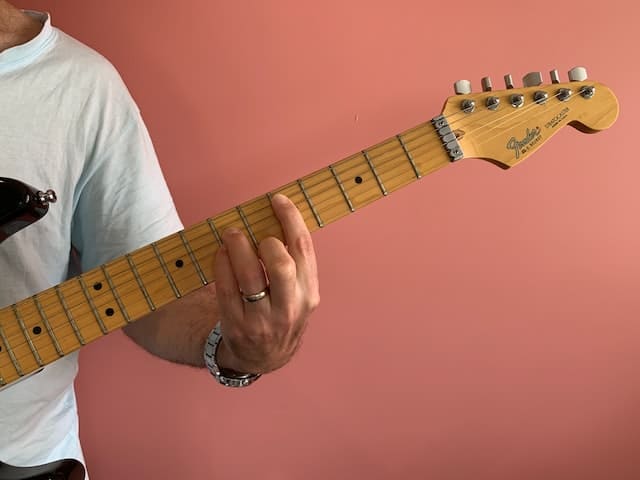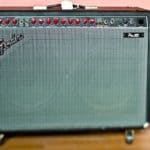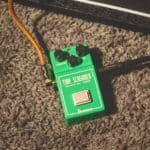If you have been playing guitar for a while now, you perhaps have read or heard someone referring to a “warm guitar tone”
But what does that actually mean?
Should you heat up your guitar in the oven? (Please don’t)
Or how do you get a warm guitar tone at home then?
Warm guitar tones are usually characterized by having an embracing midrange, and not too much harsh top end. Usually, players use tube amps for achieving these kinds of sounds since they add a certain unique saturation. Digital simulators nowadays can also get you quite close.
In this article, I will tell you all you need to know about what makes a warm guitar tone, I’ll mention some easy tips to get one, and talk briefly about the kind of gear that could favor this kind of sound.
After leaving this page, you will know exactly how to dial in a warmer tone, and understand all the small details about it.
Are you ready to get started?
Let’s go!
What does warm mean for guitar tone?
Guitarists and musicians, in general, tend to use certain words to describe concepts that probably have nothing to do with them.
But when we all refer to the same thing with the same word for enough time, things end up making sense.
I promise.
When we talk of a warm guitar tone, we usually refer to a sound that’s rich in mids, particularly low mids.
Also, warmth is usually associated with the organic feel of a tube overdrive or the one from an analog pedal.
A warm tone is not too deep, and definitely not too bright or sharp.
I consider it can be muddy, and a bit dark, but not necessarily.
This might be crazy talk for you, but if you want to know a bit more about what I’m referring to, here’s an article where I analyze all this terminology in greater detail:
Finally, another great way of characterizing a warm tone is to think of the concept as anything that just feels natural and organic, and doesn’t pierce your ears or melt your face.
7 tips for getting a warm guitar tone
Getting a warm tone is not exclusive to pro players, and I believe you can get a sound that fulfills your desires by just following these simple tips:
1. Use a tube amp
Tube amps are perhaps the most important piece of gear for achieving a warm tone.
Their secret is that when cranked they produce a series of overtones that enrich the sound as none other pieces of gear could ever do.
This is why even when tube technology is not used anymore for other applications, it’s still extremely demanded in the guitar world.
2. An amp sim will also work
Technology has come a long way in the past decade and there are a lot of simulators that can get very close to the sound of a real tube amp, and in some cases at a fraction of the cost!
3. Try an analog overdrive pedal
Classic overdrive pedals go hand in hand with tube amps for crafting legendary guitar tones.
Simulators and modern digital multi-effects do a great job of imitating their sound, and you should check them out.
4. EQ all harshness out
As I mentioned earlier, warm sounds shouldn’t be harsh or extremely bright, so taking off a bit of high-end from your amp, or your overall mix will likely not hurt your goals.
5. Roll down your tone knob a bit
Rolling down the tone knob of your guitar will act similarly to cutting highs in the EQ.
The tone knob just takes treble away from the signal.
6. Add some compression
Compressors chop off peaks from the signal, leaving you with a less dynamic sound in terms of volume.
You can then take advantage of not having as many level peaks and turning up a bit the volume.
But not only this, most looked after compressors also add a certain color to the signal that will get you a step toward the warmth you are looking for.
7. Put it all together with reverb
Reverb is a must-have effect for me, in almost all situations.
When looking for warmth in your sound, a natural sounding delay might help tidy up everything, and give you a bigger sound.
Don’t go for anything too big, just dial in something natural, and you will see what I’m talking about.
Examples of warm guitar tones
If you are still struggling to pinpoint in your mind exactly what a warm guitar tone is, I’ll leave you here with a few examples of what comes to my mind when I think of this kind of sound.
I tried to pick different players with contrasting styles so you can hear that warmth can be achieved in many ways.
Of course, being a guitar legend like these guys probably also helps.
Pink Floyd – Time
Cardinal Black – Warm Love
Led Zeppelin – Since I’ve Been Loving you
Can any guitar have a warm tone?
You can get a warm tone with just about any working guitar.
Of course, the approach might be different based on the natural sound of the instrument.
But take a look at the examples above since I didn’t choose them randomly.
David Gilmour on Time is playing with a Strat, Chris Buck is using a Yamaha Revstar with P90s, and Jimmy Page a Les Paul with PAF humbuckers.
All of them are going into tube amps, and of course, have fuzz or overdrive pedals to support them.
What I’m trying to point out here is that there’s not a single recipe for achieving warmth in your tone, but an overall framework into which you should find your fit based on what you have at your disposal.
I’m pretty sure, however, that after developing your ear a bit and following the tips I left you in this article you will have no problem getting an embracing warm tone.
Recommended gear for getting a warm guitar tone
If you are thinking of upgrading your rig to go for a warmer tone, there are certain things you should consider:
- A tube amp
- High-quality guitar pickups
- A boost or overdrive pedal
- A reverb pedal
- A compressor pedal
- An EQ pedal
Most of these I discussed earlier, but I added having a nice set of pickups in your guitar as a must since cheaper ones tend to sound too bright and harsh.

Hello there, my name is Ramiro and I’ve been playing guitar for almost 20 years. I’m obsessed with everything gear-related and I thought it might be worth sharing it. From guitars, pedals, amps, and synths to studio gear and production tips, I hope you find what I post here useful, and I’ll try my best to keep it entertaining also.





